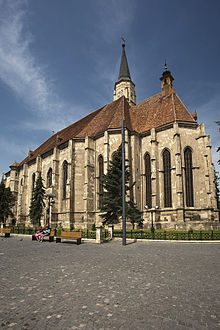St. Michael's Church, Cluj-Napoca
This article needs additional citations for verification. (October 2021) |
| St Michael's Church | |
|---|---|
| Roman Catholic Church of St Michael Biserica Romano-Catolică Sfântul Mihail (in Romanian) | |
Biserica Sfântul Mihail (in Romanian) Szent Mihály-templom (in Hungarian) Klausenburger Michaelskirche (in German) | |
 | |
 | |
| 46°46′12″N 23°35′22″E / 46.76996°N 23.58932°E | |
| Location | Union Square, Cluj-Napoca, Transylvania |
| Address | Piața Unirii 16. |
| Country | |
| Denomination | Catholic Church |
| Website | [1] |
| History | |
| Status | Active |
| Dedication | Michael the Archangel |
| Architecture | |
| Functional status | Parish church |
| Heritage designation | Monument istoric |
| Designated | 2010[1] |
| Style | Gothic, Baroque and Gothic Revival (tower)[2] |
| Groundbreaking | 1316[3] |
| Completed | 1487 |
| Specifications | |
| Length | 70 m |
| Nave length | 50 m[4] |
| Nave width | 24 m |
| Number of towers | 1 |
| Tower height | 80 m (incl. 4-m high cross)[5] |
| Materials | Stone |
| Administration | |
| Archdiocese | Alba Iulia |
| Official name | Biserica romano-catolică „Sf. Mihail” |
| Designated | 2010 |
| Reference no. | CJ-II-m-A-07469 |
The St. Michael's Church (Romanian: Biserica Sfântul Mihail, Hungarian: Szent Mihály-templom, German: Michaelskirche) is a Gothic-style Roman Catholic church in Cluj-Napoca. It is the second largest church (after the Biserica Neagră of Brașov) in the geographical region of Transylvania, Romania. The nave is 50 meters long and 24 meters wide, the apse is 20×10 m. The tower with its height of 76 meter (80 meter including the cross) is the highest one in Transylvania.
History
[edit]
The construction was begun probably in place of the Saint James Chapel. The financing of the church was partly done by the citizens, partly from the income of indulgences. The first related document, dating back to 1349 and signed by the archbishop of Avignon and fifteen other bishops, grants the indulgence for those contributing to the illumination and furniture of the Saint Michael Church. The construction was completed between 1442 and 1447, the old tower being built between 1511 and 1545. The tower that stands today was erected in 1862.
The church was converted, along with the local population, to Lutheran Protestantism between 1545 and 1566. Then the more radical Unitarian party took it over in the period 1566–1716. At last, it was confiscated in the Counter-Reformation by the Catholic Church with the support of the Habsburg government.
The Baroque clock tower was replaced in the 19th century by a new one, built in the Gothic Revival style (1837–1862).
Events
[edit]Some important historical events that took place in the church:
- 26 July 1551: Queen Isabella of Hungary gives the Hungarian Crown to General Castaldo, the deputy of Ferdinand I., and cedes with that Hungary and Transylvania
- 23 October 1556: Queen Isabella returns and takes back the reign of Transylvania, in the name of her son, the child John II Sigismund Zápolya
- 27 March 1601: the third investiture of Sigismund Báthory as Prince of Transylvania
- 12 February 1607: election of Sigismund Rákóczi as Prince of Transylvania
- 7 March 1608: election of Gabriel Báthory as Prince of Transylvania
- 13 October 1613: election of Gabriel Bethlen as Prince of Transylvania
- 18 May 1944: the speech of Áron Márton, bishop of the Roman Catholic Church in Transylvania in which he strongly condemned the deportation of Jews.
Description
[edit]The west portal is decorated with the three coats of arms of Sigismund as King of Hungary, as King of Bohemia and as Holy Roman Emperor.
The oldest of its sections is the altar,[clarification needed] inaugurated in 1390, while the newest part is the Gothic Revival-style clock tower, which was built in 1837–1862 and replaced a Baroque predecessor.
Gallery
[edit]-
General view from SE
-
Church with Baroque tower (replaced by 1862)
-
Church and city square (1840, Josef Hofreit)
-
Baroque gate into churchyard (west)
-
Church with adjacent buildings, new tower under construction (1850)
-
The 19th-century neo-Gothic tower
-
Matthias Corvinus Monument (1902)
-
The entrance (west portal)
-
The three coats of arms of Sigismund I on west portal
-
The interior
-
The vaulting system
-
Restored fresco remains
-
Pipe organ built in 1763 by Johannes Hahn
-
Sacristy made in 1528, at the order of parish priest Johannes Klein
-
Altar with the Three Magi, sculpted by Johannes Nachtigall (1717–1761), painted by Franz Anton Maulbertsch (1724–1796).
-
Glass window: Archangel Michael with Quis ut Deus? inscription
-
Glass window: Crucifixion of Jesus
-
Glass window: Jesus blessing a sword
-
Glass window: Confession of Peter
-
Glass window (1893): Mary and infant Jesus; below: Saints Astrik and Emeric of Hungary
-
Glass window: Young Jesus in Joseph's carpentry shop
-
Relief (1957): Descent from the Cross
See also
[edit]- Matthias Corvinus Monument (1902) stands in the square south of the church
- Saint Michael in the Catholic Church
References
[edit]- ^ "Lista Monumentelor Istorice". National Heritage Institute. Archived from the original on 2016-02-19.
- ^ "10 lucruri pe care nu le ştiai despre Biserica "Sf. Mihail" din Cluj-Napoca". Buna Dimineata. 2 June 2015.
- ^ "Biserica Romano-Catolica Sf.Mihail – Cluj-Napoca". Ghid Video Turistic. 14 October 2020.
- ^ "Cluj-Napoca, Biserica Sf. Mihail". Welcome to Romania.
- ^ József Lukács, Levente Várdai (2005). Povestea "oraşului-comoară": scurtă istorie a Clujului şi a monumentelor sale [The story of the "treasure city": a short history of Cluj and its monuments]. Biblioteca Apostrof. ISBN 9739279740.
External links
[edit](in Hungarian) Official page on the website of the diocese of Alba Iulia






















